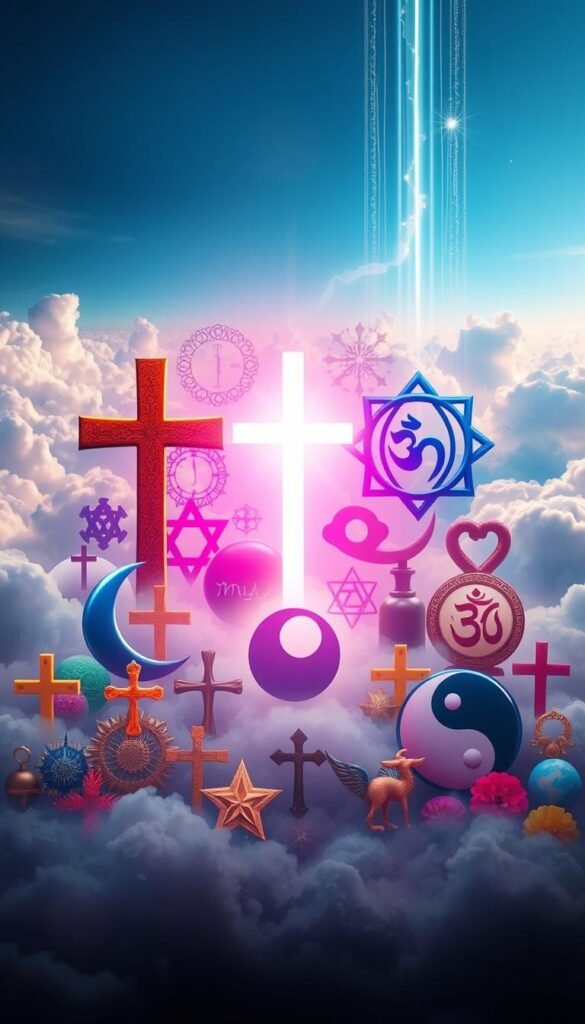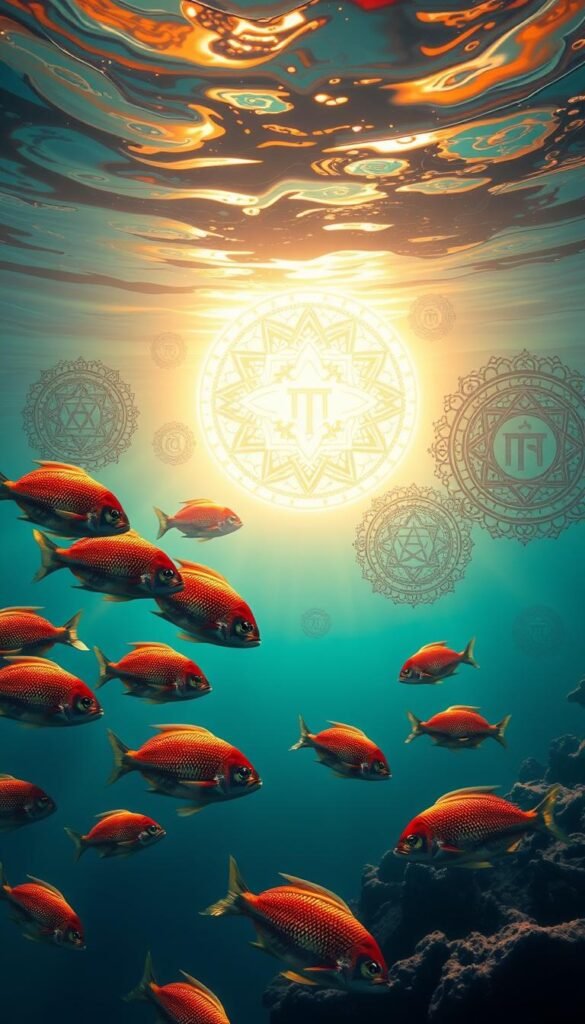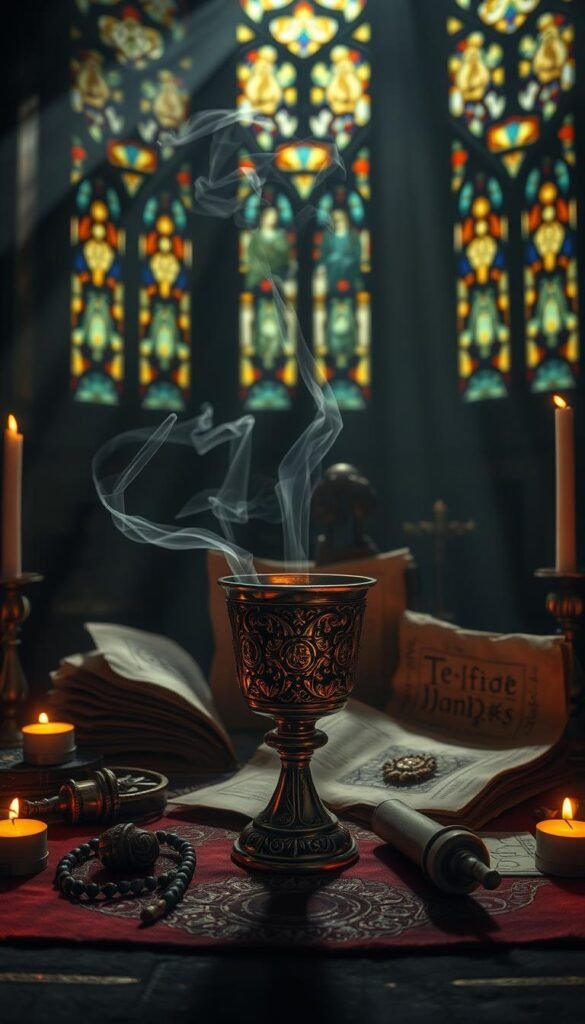Have you ever paused to wonder why certain shapes or signs feel so deeply meaningful? A cross, a circle, or even a lotus flower—these aren’t just simple designs. They carry layers of significance that connect us to something greater. Symbols act as a bridge between the visible and the invisible, offering us a way to understand the mysteries of life and the world around us.
Mircea Eliade, a renowned scholar, once described how these signs transcend rational understanding. They serve as both a veil and a revealer, hiding truths while also pointing us toward deeper insights. The Greek word “symbolon” originally referred to a token of hidden wholeness—a reminder that what we see is only part of the story.
What if every cross or circle held meanings waiting to be decoded? These signs aren’t just historical artifacts; they’re living tools that can guide us in our daily lives. By exploring their significance, we can uncover wisdom that speaks to our hearts and minds.
Key Takeaways
- Symbols act as spiritual shorthand, connecting humanity to the divine.
- They serve as both veiling and revealing mechanisms in sacred writings.
- Mircea Eliade highlighted their role in transcending rational understanding.
- The Greek origin of “symbolon” refers to a token of hidden wholeness.
- Decoding symbols can reveal layered meanings that enrich our lives.
Introduction to Symbols in Religious Texts
Across cultures and time, certain signs have spoken a universal language. From the lotus flower in Buddhism to the Star of David in Judaism, these markers transcend words. They connect people across generations, offering a shared understanding of the sacred.
In the 20th century, scholars began to see religion through a new lens. They focused on the symbolic meanings behind rituals and texts. This shift helped us appreciate how these signs shape our belief systems and create sacred spaces.
Mircea Eliade, a prominent thinker, explained how symbols act as mediators. They bridge the physical and spiritual realms, making the intangible tangible. This idea shows the importance of symbols in our daily lives, even if we don’t always notice them.
Consider this: many modern worshippers use ancient signs without realizing their history. Lighting candles, wearing specific colors, or arranging objects in certain ways—these practices carry echoes of the past. They remind us that symbols are not just relics; they are living tools that continue to guide us.
The Historical Context of Religious Symbols
Long before written language, humans used signs to convey profound truths. These markers were more than just shapes; they were tools for understanding the world and our place in it. From the earliest civilizations, these signs have played a vital role in shaping beliefs and practices.
Ancient Civilizations and Their Symbols
The history of these markers begins with ancient cultures like Mu, Egypt, and Sumer. In Mu, sacred geometry included the circle (representing eternity), the triangle (the trinity), and the square (earthly existence). These shapes were not just artistic; they held deep spiritual meaning.
Egyptian hieroglyphs evolved from simple solar disks to complex compounds. The rayless sun in the “Book of the Dead” symbolized the destruction of Mu. Meanwhile, Sumerian ziggurats physically manifested the square-earth concept, showing how architecture and symbols were intertwined.
The Role of Symbols in Early Religious Practices
In early practices, these markers served as bridges between the physical and spiritual realms. Archaeological evidence, like the 12,000-year-old Uxmal temples, shows symbolic continuity across time. These signs were not static; they evolved with human understanding.
Today, we often use rational markers like “=” or “♂.” But ancient sacred signs carried layered meanings. They were not just tools for communication; they were gateways to the divine. By studying these markers, we can better understand our shared history and the enduring power of visual language.
Common Symbols Across Major Religions

Why do some designs resonate so deeply across different cultures? From the cross to the wheel, these images carry meanings that transcend time and geography. They connect us to shared truths and guide us in our spiritual journeys.
The Cross in Christianity
The cross is one of the most recognizable signs in the world. Originally a tool of execution, it transformed into a beacon of hope over centuries. The Tau cross, shaped like the letter “T,” symbolizes both suffering and resurrection.
Early Christians used the fish, or ichthys, as a secret identifier during persecution. This simple design carried profound meaning, representing faith and unity. Today, the cross stands as a reminder of sacrifice and new beginnings.
The Dharmachakra in Buddhism
The Dharmachakra, or Dharma wheel, is a central symbol in Buddhism. Its eight spokes represent the Noble Eightfold Path, guiding practitioners toward enlightenment. The hub, spokes, and rim symbolize wisdom, ethics, and concentration.
This wheel is often linked to Buddha’s first sermon, where he set the teachings in motion. It serves as a reminder that every action has consequences, shaping our life and spiritual journey.
| Symbol | Religion | Meaning |
|---|---|---|
| Cross | Christianity | Sacrifice, resurrection, hope |
| Dharmachakra | Buddhism | Enlightenment, ethics, wisdom |
Both the cross and the Dharmachakra show how simple designs can carry deep spiritual truths. They remind us that even the smallest symbol can hold the weight of centuries of belief and practice.
The Spiritual Significance of Religious Symbols

What if the shapes we see hold keys to unlocking deeper truths about our existence? From ancient times, certain designs have been used to guide the soul and reveal hidden meaning. These forms are not just art; they are tools for spiritual awakening.
In the Egyptian “Book of the Dead,” the heart is weighed against Maat’s feather of truth. This act symbolizes the balance between morality and the soul‘s journey. It reminds us that our actions have consequences beyond the physical world.
Mu’s teachings emphasize how these designs focus the mind during worship. Mandalas and yantras, for example, act as maps of consciousness. They help practitioners center their thoughts and connect with the divine.
The Ankh, often called the key of life, merges masculine and feminine energies. It represents the union of opposites, offering a deeper meaning to existence. This ancient sign continues to inspire seekers of truth.
Zen enso circles are another powerful example. They express the formless form of enlightenment. These simple yet profound designs remind us that true understanding transcends physical boundaries.
In medieval exegesis, scholars contrasted literal and anagogical interpretations. This approach highlights how belief systems evolve over time. It shows that spiritual truths can be layered and multifaceted.
Here’s a simple meditation technique using yantra geometries:
- Choose a yantra that resonates with you.
- Focus on its center, allowing your mind to settle.
- Visualize its patterns expanding, connecting you to universal energy.
This practice bridgesscienceand spirituality, offering a practical way to explore inner peace.
Symbols in Religious Texts: A Deeper Dive

What do a fish and a circle reveal about humanity’s spiritual journey? These two designs—one organic, one geometric—carry layered meanings across cultures. Let’s explore how they guide seekers even today.
The Fish Symbol in Early Christianity
The ichthys (ΙΧΘΥΣ) wasn’t just a secret marker for persecuted Christians. Its Greek letters formed an acrostic: Iēsous Christos Theou Yios Sōtēr (“Jesus Christ, Son of God, Savior”). Gematria assigns it the numerical value 1224, linking to divine order.
Interestingly, Hinduism’s Vishnu appears as Matsya, a fish avatar saving sacred knowledge from floods. Both traditions use this creature to represent preservation through turbulent times.
The Circle and Its Eternal Meaning
From Mu’s sun disks to Zen enso paintings, the unbroken curve speaks of wholeness. Dante’s Divine Comedy mapped the soul’s ascent through concentric rings—each level revealing deeper truths.
Modern physics echoes this with the ouroboros (a snake eating its tail). It symbolizes energy’s endless cycle, mirroring ancient Hindu śūnyata (emptiness) teachings.
| Symbol | Culture | Core Meaning |
|---|---|---|
| Ichthys | Christianity | Salvation, hidden wisdom |
| Circle | Global | Eternity, life cycles |
Try this: Draw a mandala with repeating circular patterns. As you create each ring, reflect on how endings always birth new beginnings—nature’s timeless lesson.
The Role of Symbols in Rituals and Worship

How do simple objects like bread or a lamp become sacred in worship? Ordinary things transform into vessels of meaning through rituals. They bridge the physical and spiritual, helping people connect with the divine.
In Catholicism, the Eucharist turns bread and wine into the body and blood of Christ. This ritual echoes the Passover meal, where unleavened bread symbolized haste and freedom. Over centuries, it evolved into transubstantiation—a mystery where the mundane becomes holy.
Hindu puja rituals illuminate consciousness. Lighting a lamp before deities represents dispelling ignorance. The flame’s steady glow mirrors focused intention, a practice shared across cultures.
Native American medicine wheels map ceremonial spaces. These circles, often made of stones, align with cardinal directions. They guide prayers and healing, showing how geometry shapes acts of worship.
Muslim prayer mats use geometric patterns to focus intention. Each line directs the worshipper toward Mecca, turning a simple rug into a sacred compass. Similarly, Buddhist bells and Christian sanctus bells mark transitions—calling minds to presence.
“Rituals are the poetry of the invisible world.”
Masonic rites preserve ancient builder rituals. Tools like the square and compass aren’t just instruments—they teach moral alignment. Here, craftsmanship becomes a metaphor for inner growth.
These practices remind us: sacredness lives in the everyday. A piece of bread, a woven mat, or a circle of stones can awaken awe. When we engage with intention, ordinary things reveal extraordinary depths.
Symbols and Their Psychological Impact
Have you ever felt your pulse quicken at the sight of certain images? That visceral reaction is your brain’s ancient wiring at work. For human beings, visual cues like serpents or crosses trigger deep psychological responses—faster than conscious thought.
Carl Jung revealed how archetypes live in our collective unconscious. The “shadow” archetype, often shown as demonic figures, activates the amygdala—our brain’s alarm system. This explains why cultures worldwide associate snakes with danger, despite different belief systems.
“The archetype is a psychic organ present in all of us.”
Sacred geometry works differently. Yantras with precise ratios create neural entrainment—brainwaves syncing to their patterns. Studies show these designs reduce stress by 27% more than blank meditation. The Sri Yantra’s interlocking triangles literally reshape focus.
Colors speak a universal language too:
| Color | Psychological Effect | Spiritual Meaning |
|---|---|---|
| Red | Increases heart rate | Passion, life force |
| Blue | Calms nervous system | Divine connection |
| Gold | Enhances focus | Enlightenment |
A 2021 UCLA study used symbolic re-scripting to treat PTSD. Patients redesigned traumatic images—turning war helmets into nesting doves. This reduced flashbacks by 63%, proving symbols can rewrite emotional memory.
Mircea Eliade’s “eternal return” concept shows how rituals use repeated signs to heal. Lighting candles or drawing mandalas taps into this timeless psychology. These acts tell our brains: “This space is safe.”
Here’s why this matters today: We’re the first human beings bombarded by thousands of symbols daily. Social media icons, logos, emojis—they all tap into these ancient pathways. Understanding their power helps us choose which ones shape our inner world.
Reflect: What personal symbols appear in your dreams or doodles? A recurring shape might be your psyche’s way of sharing wisdom. As Jung showed last century, these patterns connect all beings across time and culture.
Recognizing their importance gives us tools to navigate both spiritual and digital landscapes with greater awareness.
The Evolution of Religious Symbols Over Time
Time reshapes everything, even the most sacred designs we hold dear. The cross you recognize today began as a Greek tau (T), evolved into the Latin cross, and later gained the crucified Christ. Each change reflected shifts in theology—from resurrection emphasis to suffering’s role in redemption.
Few transformations are as striking as the swastika’s journey. For 5,000 years, this sun-wheel symbolized prosperity in Hinduism and Buddhism. Nazi appropriation in the 20th century rewrote its meaning globally, showing how symbols can be weaponized across time.
The menorah’s path mirrors Jewish resilience. A temple implement in antiquity, it became Israel’s national emblem in 1949. This seven-branched lampstand now represents both divine light and cultural identity—a fusion of sacred and secular.
“Symbols are living things—they breathe with the cultures that carry them.”
Om (ॐ) absorbed meanings like a spiritual sponge. Originally a Hindu sound of creation, it now bridges Buddhism’s mindfulness and Jainism’s ahimsa. Its layered vibrations show how one symbol can unify diverse beliefs.
Digital age adaptations raise new questions. Prayer hands emoji (🙏) simplify the nuance of traditional mudras—are they diluting meaning or expanding access? Meanwhile, neopagans reclaim the inverted pentagram from satanic panic, restoring its pre-Christian earth-element symbolism.
Trace the crescent moon’s path:
- Diana’s bow in Roman myth
- Byzantine Constantinople’s emblem
- Ottoman adoption in the 15th century
- Modern Islamic identifier
These shifts remind us: no symbol exists outside history. They’re mirrors reflecting humanity’s changing understanding of the sacred. As we use these designs today, we become part of their ongoing story—a conversation spanning millennia.
Misinterpretations and Controversies Surrounding Religious Symbols
When does a spiritual marker cross into controversy? Throughout history, sacred designs have sparked debates that reveal more about cultural tensions than the things themselves. These conflicts often arise when signs travel beyond their original contexts.
The 1980s Satanic panic showed how fear reshapes meaning. Christian groups claimed backward masking in rock music hid demonic messages. This belief transformed harmless audio glitches into perceived threats, demonstrating how anxiety distorts interpretation.
Post-9/11 misunderstandings targeted Sikh people wearing kirpans. These ceremonial daggers represent spiritual discipline, yet airports banned them as weapons. The clash between religious practice and security concerns continues today.
“A symbol is like a river—it carries different meanings to those who drink from it.”
Christian yoga debates ask: Can stretching be separated from Hindu roots? Some churches rebrand poses as “Praise Moves,” while others embrace the practice’s origins. This tension mirrors larger questions about cultural exchange.
Consider these contrasting cases:
| Symbol | Original Meaning | Controversial Interpretation |
|---|---|---|
| Confederate Flag | Southern heritage | Racial oppression |
| Buddha Head Statues | Enlightenment | Theravada aniconism violation |
The 2006 Muhammad cartoon crisis showed how visual representation can ignite global protests. What some saw as free speech, others viewed as blasphemy. This divide highlights how symbols operate across different value systems.
At the end of the day, these conflicts invite us to ask: Where’s the line between adaptation and appropriation? Perhaps the answer lies in respecting origins while allowing growth. After all, even the cross evolved over centuries.
Next time you encounter a disputed design, pause. Ask yourself: Is this about the symbol itself, or what people project onto it? The most powerful markers often hold space for multiple truths.
Conclusion: The Enduring Power of Symbols in Religious Texts
Neuroscience confirms what mystics knew: visuals shape the soul. From mandalas to crosses, these designs bridge our finite minds with infinite concepts. Studies show they activate brain regions linked to meaning and memory.
Try this: Sketch a simple shape that resonates with you. Layer it with meaning—a reminder, a prayer, or a hope. Like Mu’s teaching says, “These are fingers pointing at the moon’s truth.”
What patterns will guide our evolution? Whether through science or faith, they remain tools to anchor your journey. The next time you pause before a familiar design, listen. It might whisper wisdom older than words.
